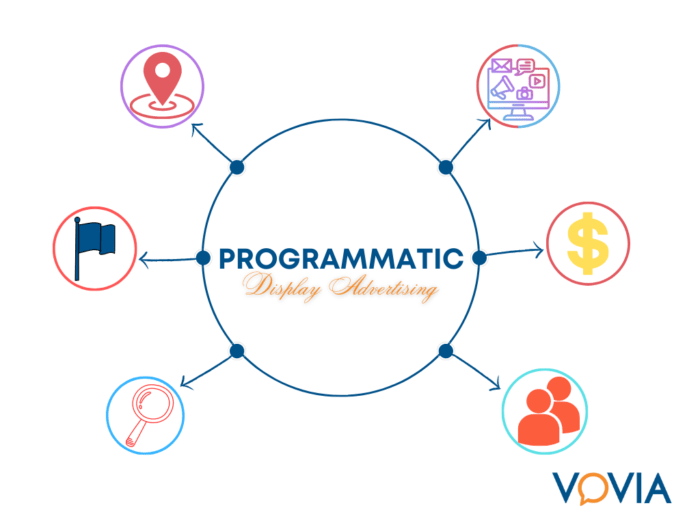Programmatic Display Advertising: Comparing GDN and DSPs
What is Programmatic Display Advertising?
Programmatic display advertising (“Programmatic”) is an approach to digital marketing that leverages data and automation. It is a method of buying and selling display ads—that appear in designated areas of websites, social media platforms, or mobile apps—through machine learning that targets specific demographics and/or their online behaviours. Display ads come in a variety of formats, including text, audio, video, gifs, pictures, HTML5, flash, and more. Programmatic is offered by all of the major ad platforms such as Google, Facebook and Amazon, in addition to DSPs.

What is a DSP?
- DSPs (Demand Side Platforms) are marketing platforms that execute programmatic display advertising campaigns, targeting specific audiences with personalized ads on websites and apps through online Ad Exchanges. DSPs have advanced targeting capabilities that help advertisers reach their desired audience more precisely. These platforms largely use third-party data and algorithms to analyze user behaviour, demographics, interests, and other factors. With this information, DSPs enable advertisers to target specific audience segments based on parameters like age, gender, location, interests, browsing history, and more.
- There are many DSP platforms available. Some are self-serve platforms such as Google DV360 and TradeDesk, in which you enter and manage your buy parameters manually. Others are managed platforms where you secure a direct buy through a provider and they execute the campaign on your behalf. Examples of these platforms include Pelmorex, Native Touch, Quantcast, and many others.
What is the difference between Google Display Network and DSPs?
- Google Display Network (GDN) is a network of websites, apps, and platforms where advertisers place their ads. It offers a wide online reach and access to Google’s vast digital inventory via Google’s AdSense platform. Marketers using Google Ads can bid on display advertising options and use data already in Google to create their targeting for those advertisements. Reaching specific audiences is simple with this method, especially if you are already comfortable with and employ Google’s marketing tools.
- DSPs are third-party platforms that let you bid on or buy ad inventory from multiple sources at the same time. It connects multiple ad exchanges, allowing them to access inventory from various sources beyond Google.
- Even though GDN technically falls under the category of a demand-side platform, its capabilities are quite constrained when compared to those of a real DSP. In reality, Google offers a fully functional DSP called “Display and Video 360,” which offers considerably more advanced targeting and reporting options.
GDN vs DSP
- GDN integrates seamlessly with Google Ads, enabling advertisers to manage their campaigns on a single platform and leverage Google’s powerful suite of ad management tools and reporting features. Also, it enables you to leverage existing data and reporting from search marketing and other efforts. It facilitates cross-format campaigns (search, display, etc.) for holistic online branding and awareness.
- DSPs have access to more inventory, including premium or exclusive publisher content, through all of the ad exchanges, not just Google’s network of sites.
- DSPs offer more advanced targeting capabilities, leveraging first and third-party data (being used less and less with privacy changes) to target specific audiences based on demographics, interests, and behaviours.
- DSP’s provide greater control and customization options for ad campaigns to reach the desired audience with greater precision.
- DSPs offer more creative format options and placements, such as Rich Media, Takeover, and Native Ads.
- Cost: Whereas most of the DSP providers require a minimum monthly spend, GDN does not have any minimums. DSPs often involve platform fees, and transaction fees, which can add to the overall advertising costs. It is very common for platforms to hide these charges as part of the media cost, making it difficult for advertisers to know how much of their media cost is actually being spent on the buy and how much is being charged by the platform for serving the ads. Whereas GDN does not charge an additional platform fee meaning all of the media investment is going to the buy.
- DSPs offer measures for brand safety and fraud prevention that are integrated with top third-party verification companies. In contrast, GDN does not support third-party integrations and solely provides brand safety controls for Google Ads.
- While GDN is open auction only and includes many smaller publishers that cannot qualify to sell their inventory elsewhere, including Google’s premium exchange, DSPs can purchase the inventory across all value levels.
Other considerations for DSP
- Limited access: Some premium publishers or inventory sources may not be available on all DSPs, potentially limiting the reach and access to specific desired audiences or high-value placements.
- Data privacy concerns: DSPs handle vast amounts of user data, and there are potential privacy concerns associated with the collection, storage, and usage of this data. DSPs rely heavily on third-party cookies for targeting data, which is becoming increasingly challenging given the changes happening in privacy regulations. This also makes targeting less effective.
- Inventory availability: In areas with lower populations, the available ad inventory might be more limited compared to densely populated areas. This could result in fewer options for ad placements and potentially higher competition for available impressions. This can also mean spending the minimum budget could be difficult and result in needing to open up targeting to spend the budget.
- Targeting granularity: Targeting specific audience segments in areas with lower populations might be more challenging due to a smaller pool of users and potentially limited data.
Ultimately, the choice between GDN and DSPs depends on the specific needs and goals of advertisers. GDN is suitable for those who prioritize the integration with Google Ads, leveraging existing data, and require a simpler and cost-effective solution. On the other hand, DSPs are ideal for advertisers seeking advanced targeting capabilities, access to a wider range of inventory, and greater control over their ad campaigns.